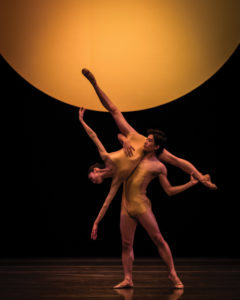Singapore: Winter 2017 - Vancouver Ballet Society
- Home
- City Reports 2015 - 2019
- Singapore: Winter 2017

by Malcolm Tay
As an independent dance artist in Singapore, Eng Kai Er found that ambiguous intentions and unstated assumptions often hampered the experience of collaborating with other dancer-choreographers. To cope with these obstacles and rein in her own nature to be bossy, Eng says, she came up with a framework for the creative process in which each collaborator takes turns leading rehearsals and developing material, with no single person controlling the proceedings or making decisions on the final product. This egalitarian approach resulted in the birth of The Roundest Circle, which Eng devised and performed with Faye Lim and Felicia Lim (who are not related). It was recently presented by local arts group TheatreWorks, where Eng has been an associate artist, at the revamped rice warehouse called 72-13.
As viewers took their seats on three sides of the white-walled performance space, the trio could be seen warming up in matching grey sweat suits. The uniform costuming was the only sedate part of the hour-long show, whose eclectic format reflected the diverse personalities and interests of its creators. After a jointly recited prologue about three witches who try to lure an evil king into a pit of three-headed snakes to avenge their sister’s death, the women made separate forays across the bare stage before they fell into a heap. Then, long hair curtaining their faces, they transformed into a shaggy, three-headed monster that lumbered around waving a comb and swaying to Ella Fitzgerald.
Were they playing the witches as conjoined triplets? This image was soon dismantled as the performers huffed and strained to pile themselves into a series of human pyramids and increasingly complex lifts, their bodies cantilevering at precarious angles. Such sweaty effort was also evident in the four-round wrestling match later in the show, where they kicked and jostled to be the last one standing within a rectangle projected on the floor. These scenes book-ended a conversation in which the dancers meandered from the topic of Faye Lim raising her toddler to discussing child abuse. What could all this mean? Perhaps The Roundest Circle was the trio’s way of expressing life as a constant tussle for balance and purpose, regardless of having kids.
Weird creatures also appeared in Le Syndrome Ian, which had its Asia-Pacific premiere in August at the Singapore International Festival of Arts. In this 2016 production — the closing chapter of French choreographer Christian Rizzo’s trilogy based on anonymous dances — nightclub dancing was uprooted to the stage and rejigged for a cast of nine in short-sleeved white tops and navy pants.
Clustering upstage at the start, the dancers broke away to slowly gather in twos and threes, trading partners with offhand intimacy. When the music by Pénélope Michel and Nicolas Devos hit its groove, they loosened up and burst into a disco-styled step-touch, gradually adding jumps, turns and other details. At several points, a shadowy figure emerged to watch the performers from afar. Seven such creatures eventually took over the School of the Arts Drama Theatre stage, like a silent threat that had been allowed to grow until it became unstoppable. By the end just one remained, peeling off its fuzzy suit to reveal a woman: her tense, quivering solo felt like a defiance against the odds.

Photo: Bernie Ng
Edwaard Liang’s newest commission for Singapore Dance Theatre finished, too, with the spotlight on a lone dancer, but in this case it was for a more disquieting effect. 13th Heaven, the Taiwanese-American choreographer’s fifth work for the troupe, premiered at the Esplanade Theatre in July on a triple bill that also featured the company premiere of The Four Temperaments. The dancers gave a modest account of Balanchine’s spiky inversions of classical technique, but looked more confident tackling Liang’s liquid shapes and intricate duets. Set to a mix of string pieces by English composer Oliver Davis, 13th Heaven depicted a community in flux against a large amber moon, with principal artist Chihiro Uchida first to venture away from the ensemble of 16. Was this why she was expelled from the group and left sprawling on the ground as the piece concluded?
Meanwhile, Frontier Danceland shook up its programming by staging a performance in a non-theatre venue. In Improv-tu, company member Joy Wang led six other dancers in improvising individual and collective journeys through the showroom of Swedish furniture brand Möbler. The space itself was interesting, with vintage chairs, dressers and homeware stacked around a main pillar; table and floor lamps cosily enhanced the afternoon light from high grilled windows.
To a live soundscape by a local musician named sullen, the performers explored and navigated this craggy terrain of old furniture that suggested the emotional clutter of nostalgia. Ultimately, they arranged a pathway of chairs, stepping over and through it until they reached the exit.
Tags: Chihiro Uchida Christian Rizzo Edwaard Liang Eng Kai Er Faye Lim Felicia Lim international dance news Kenya Nakamura modern and contemporary dance Singapore Singapore Dance Theatre